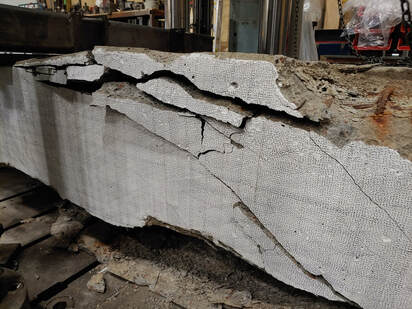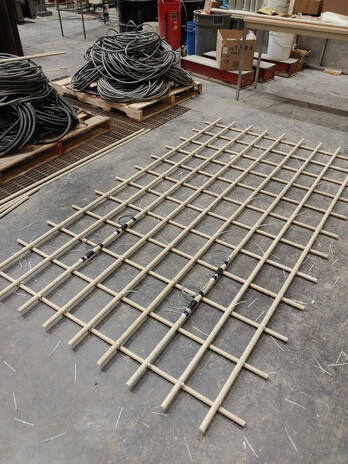MY SITE
Bridges are critical links in our transportation infrastructure. Imagine how your day-to-day life is affected by bridges and how would it change if those bridges were closed. How can we better take care of our existing bridges and build new, more resilient, bridges for future generations?
Response of Deteriorated Prestressed Concrete Girders
|
Lead: Zhaohan (Frida) Wu
Co-supervised project with Carlos 'El Lobo' Cruz-Noguez Prestressed concrete (PC) bridges are a major component of North America’s transportation network. As our network ages, the response of deteriorated PC bridge girders is of interest since rehabilitation and repairs are constrained by infrastructure budgets. As part of a larger initiative to develop reliability-based bridge management tools for deteriorated structures, destructive tests on a 28-year old PC bridge removed from service in Alberta were completed. The impact of deterioration on semi-lightweight PC girders subject to real-world environmental effects is rarely studied. Destructive testing was carried out on 11 m single span, semi-lightweight PC girders with different types and degrees of deterioration. Both flexural and shear testing was conducted to provide insight on the deteriorated behaviour of the girders. Deterioration decreased the flexural strength of the girders. Corrosion also led to undesirable strand rupturing prior to yielding which reduces failure deflection and warning. Shear tests showed how shear span-to-depth ratio affects failure mode. All specimens loaded 1.0 m from the support failed by strut crushing. Specimens loaded 1.5 m from the support heme, girders in fair condition failed by shear compression. However, when stirrups were corroded, diagonal tension failure occurred leading to excessive yielding and wide cracks. Deterioration did not greatly impact the peak shear load for the tested girders but did affect events (e.g. first cracking) leading up to failure. |
GFRP-Reinforced Bridge Barrier Systems
|
Modelling lead: Abdullah Al-jaaidi (MSc)
Experimental lead: Juan Torres (Current MSc student) Thesis (Abdullah): https://era.library.ualberta.ca/items/a88b2d00-502d-4a94-b436-bef7a2150003 In an era where deterioration has become a pressing concern for future bridge construction, glass fibre-reinforced polymer (GFRP) reinforcement has emerged as an alternative to steel due to its superior corrosion resistance. Research on bridge decks and barriers with GFRP bars is well established with design provisions incorporated in the Canadian Highway Bridge Design Code (CHBDC). However, the CHBDC does not provide guidance on repairing GFRP reinforced concrete (GFRP-RC) bridge barriers in case of damage caused by vehicle impact. Therefore, this project aims to assess the feasibility and efficiency of repair techniques on damaged GFRP-RC bridge barriers. To fulfil this objective, this project is divided into two parts, an analytical part and an experimental part. The experimental part, currently underway, presents full-scale single-slope Alberta Transportation (AT) RC bridge barriers (used for moderate to high traffic volume highways) reinforced either with steel or GFRP bars, or a combination of the two. The analytical part of this research presents simulations of different repair techniques and simulations of the proposed specimens using finite-element analysis (FEA) software. The analysis results were studied and compared in terms of barrier wall strength, failure mode, deflections, and bar strains to evaluate the performance of GFRP-RC barriers and the efficiency of the proposed repair techniques. All repair techniques and scenarios for GFRP reinforced barrier overhangs effectively restored most of the original designs' capacity. A parametric study using FEA was also conducted to assess the influence of parameters (e.g. deck thickness, overhang length, dowelled bar spacing) on the proposed barrier designs and repairs to find optimal design values. |
Establishing Baseline Structural Health Information for an Extradosed Cable Stayed Bridge
Lead: Arnold Vendiola
Arnold’s research is focused on developing a structural health monitoring (SHM) system for a new extradosed cable-stayed bridge designed to carry light-rail transit and pedestrian traffic. SHM consists of using various sensors such as accelerometers, GPS, strain gauges, and anemometers that are used to quantify parameters such as vibration and displacement. A common goal of SHM systems is to quantify modal properties (e.g. natural frequencies) of a structure. Since the modal properties of a structure are dependent on physical properties such as mass and stiffness, a change in the modal properties of a structure can imply damage or major changes to the structure’s stiffness. The SHM system being implemented consists of strain gauges and accelerometers to measure strain and vibration during construction. An analytical model using CSiBridge is also being developed to compare field data with theoretical data. Extradosed bridges are a rare type of bridge and there are few studies which focus on the vibrational properties of these bridges.
Arnold’s research is focused on developing a structural health monitoring (SHM) system for a new extradosed cable-stayed bridge designed to carry light-rail transit and pedestrian traffic. SHM consists of using various sensors such as accelerometers, GPS, strain gauges, and anemometers that are used to quantify parameters such as vibration and displacement. A common goal of SHM systems is to quantify modal properties (e.g. natural frequencies) of a structure. Since the modal properties of a structure are dependent on physical properties such as mass and stiffness, a change in the modal properties of a structure can imply damage or major changes to the structure’s stiffness. The SHM system being implemented consists of strain gauges and accelerometers to measure strain and vibration during construction. An analytical model using CSiBridge is also being developed to compare field data with theoretical data. Extradosed bridges are a rare type of bridge and there are few studies which focus on the vibrational properties of these bridges.


